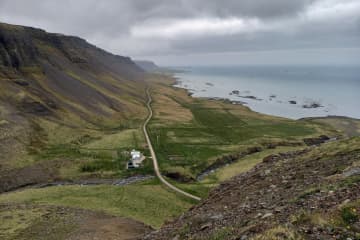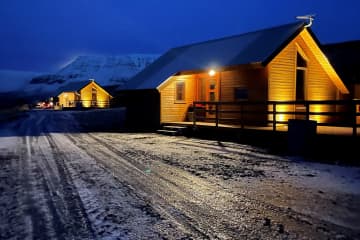Skarðsströnd coast








The route via Klofningsvegur no. 590 runs through Hvammssveit, Fellsströnd, Klofningur, Skarðsströnd and Saurbær. Day-to-day it is called going around the coasts.
Until 1918 the boundaries of Skarðsstrandarhreppur were from Ormsstaðir to Fagradalsá, then the district split into Klofningshreppur and Skarðshreppur. The district boundary held until 1986 that Klofningshreppur split over Klofningur between Fellsstrandarhreppur and Skarðshreppur.
In Dagverðarnes, Auður Djúpúðga ate a breakfast in her search for her settlement columns. The current church in Dagverðarnes was built in 1934. Outside Dagverðarnes lies Hrappsey where the country's first secular printing house was operated.
Klofningur is a natural gap and the road runs through it. At Klofningur there is a sightseeing point and a good view over the islands and out to Snæfellsnes.
One of the oldest manor in the country is Skarð á Skarðsströnd. It is the settlement land of Geirmundur heljarskinn and the same family has lived there since the 11th century. Farmers church is in Skarð and there is, among other things, an altarpiece that Ólöf "the rich" Loftsdóttir is said to have given to the church. Below Skarð is Skarðsstöð. There is a lot of bird life and cultural monuments. Skarðsstöð was the first legalized trading center in Dalasýsla in 1884 and now houses a fishing port.
The community center Röðull is located below the road by Búðardalsá. In Röðull there are often exhibitions related to the life and culture of the people of Skarðsströnd. In the 18th century, Magnús Ketilsson, an magistrate and a great progressive man, lived in Búðardalur and did significant agricultural experiments and wrote a number of scholarly articles. Ytri-Fagridalur is the innermost town on Skarðsströnd and is the settlement land of Steinólfur "the low". Over there you can see Hafratindur, the mountain of Dalir.


